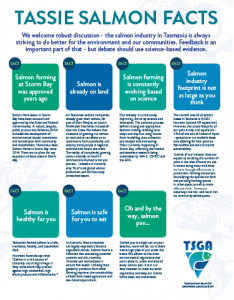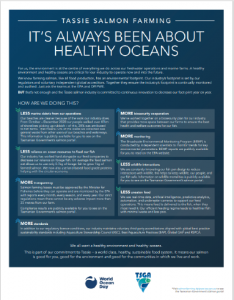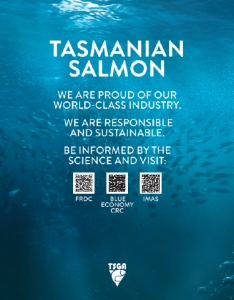FAQ
Here are the facts
Salmon farming is already on land
All Tasmanian salmon companies already grow their salmon, for part of their lifecycle, on land in freshwater hatcheries located all over the State. We believe that a balance of growing our salmon on land and at sea allows us to continue to farm sustainably and employ more people in regional communities across the state. The reality of completely growing salmon entirely on land (in commercial volumes) is not yet proven, – indeed it is currently only 1% of total global salmon production and still has many unresolved issues.
The Tasmanian salmon farming footprint is small
The current area of all salmon leases in Tasmania is 4,002 hectares (around 40 square km). However, the actual footprint of all pens combined is only one square km – 1/5th of the size of Hobart Airport – spread over our available lease area allowing for best practice fish welfare and environmental sustainability. Growth of our industry does not equate to doubling the number of pens or the area of water we use. It means doing more with what we have through efficiencies in production, farming innovation, diversifying the species we farm and pursuing farming spaces in other states as well as more efficient feed. Tasmanian waterways are not, and never can be, overrun by salmon pens.
Tasmanian farmed salmon is a safe, nutritious, healthy, and sustainable food
In Australia, feed companies are legally required to disclose ingredient details. Salmon feed is a balanced diet containing essential proteins and oils, vitamins, minerals and antioxidants to ensure fish health. Utilising food grade by-products from other farming improves the sustainability of both land-based agriculture and sea-based aquaculture. Nutrition Australia says that “Salmon is a rich source of (naturally occurring) omega-3 fatty acids which help protect against high cholesterol, high blood pressure and inflammation.”
There are no growth hormones or antibiotics in the Tassie salmon you eat
Like humans, sometimes salmon need antibiotics. Our vets are the only ones who can prescribe antibiotics. Due to the strict withholding period prior to harvest, any antibiotic has completely faded from the fish. Antibiotic use is audited and reported to government and veterinary medications are registered and monitored federally.
Salmon is not dyed or coloured
All salmon, whether they are wild or farmed, get their signature flesh colour from their diet, from the presence of an antioxidant called astaxanthin, which is vital for healthy muscle growth and egg production. Astaxanthin is safe for both salmon and humans; you can buy it from your pharmacy or health food store. Wild salmon get their astaxanthin from eating krill, farmed salmon get their astaxanthin as part of their diet.
Salmon is not part chicken
All animal feed in Australia is rigorously controlled by the federal government. Salmon is not fed unprocessed poultry products. Our feed includes poultry by[1]products that are ground down into a protein flour. Over the past 35 years, the industry has actively worked to increase the level of plant and vegetable contained in a balanced salmon diet and reduce wildfish inputs.
Salmon does not include a cancer-causing pesticide
Most animal feed, as well as a lot of human food, contains preservatives. These preservatives are approved by the Federal Government and are safe. Some salmon feed contains ethoxyquin. However, you would need to eat more than 4 kilos of salmon every day to reach the World Health Organisation (WHO) daily limit for a preservative like ethoxyquin.
The Tasmanian salmon industry is heavily regulated
There are over 40 laws currently in place to regulate Tassie’s salmon industry. These regulations, and our reporting requirements, are significantly stricter than any other industry in this State. We know this is needed to protect our freshwater and marine waterways to ensure our industry is here for generations to come. The Tasmanian government regulations are touted as the most stringent in the global salmon industry, which we can all be proud of. (EPA/NRE Tas)
Tasmanian salmon has a low carbon footprint
By eating Tassie salmon, you’re eating one of the healthiest and most efficient foods on the planet and supporting your local community at the same time. Tassie salmon also has a low carbon footprint compared to some other sources of protein. In fact, it takes only 0.7kg of wild fish to get 1kg of growth of salmon, meaning we are a net protein producer.
The salmon industry is the highest value producer of food in Tasmania
Contributing an annual value of around $900 million. It directly and indirectly supports over [10k] jobs, making it one of Tasmania’s biggest employers particularly within regional communities.
Growing conditions in Macquarie Harbour are conducive to finfish production
- Provided production limits are well controlled and scientifically based.
- Past environmental issues were a combination of multiple factors including the finfish biomass at the time. TSGA supports the biomass cap that applies to the Harbour and is pleased to see that independent environmental monitoring (IMAS) shows the health of the Harbour is improving.
- It is important to recognise that Macquarie Harbour with its very unusual and unique hydrodynamics cannot be compared to areas such as Storm Bay which has completely different and high energy hydrodynamics.
Additional Resources
Click the images or text below to access additional information.


